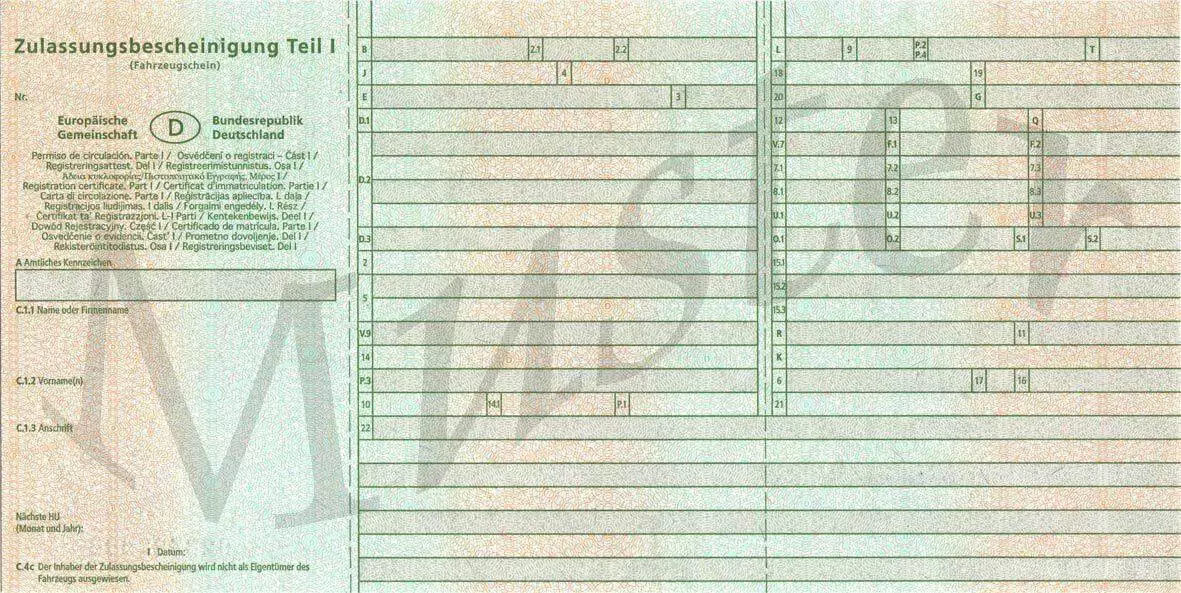Based on the HSN, TSN, KBA, the manufacturer, the model and the engine of the car or vehicle can be determined. You can store and evaluate the data in the vehicle administration of the CATAMA software . Read below what the HSN and TSN codes mean in detail and where you can find this information. Furthermore, the CATAMA is equipped with a KBA search to simplify the vehicle system.
KBA – Federal Motor Transport Authority number
The KBA number represents the combination of the HSN and the TSN. The Federal Motor Transport Authority offers a complete list of manufacturer key numbers on its website. Several HSN assignments for the same manufacturer are also possible. This is mostly the result of restructuring and name changes.
HSN – Manufacturer Key Number
The manufacturer key number (abbreviated: HSN) is a four-digit, numeric code. This can be used to clearly identify the manufacturer of the vehicle. The key number can be found in part I of the registration certificate under item 2.1. In older vehicle registration documents - issued up to September 30, 2005 - the manufacturer key number is in field 2. In general, the manufacturer number (HSN) is managed by the Federal Motor Transport Authority in Flensburg, which reports to the Federal Ministry of Transport and Digital Infrastructure.
A vehicle can be uniquely identified and classified by combining the HSN and the TSN (see type code number). The data can be easily recorded in CATAMA software and is also searchable.
Short facts about the manufacturer key number (HSN)
The HSN consists of a four-digit sequence of numbers and is noted in the vehicle registration document.
With a new vehicle registration document (registration certificate part 1), the HSN code is in field 2.1. For a motor vehicle manufactured before 2005, the MPN is simply noted in field 2. The same applies to the vehicle registration document (registration certificate part 2).
TSN – Type Code Number
The TSN is an eight-digit alphanumeric code. This stands for the key number type, variant and version of a vehicle. The first three values specify the model, for example Punto or Golf. The last 5 digits of the TSN, on the other hand, define the vehicle more precisely and contain, for example, information on the body shape, engine and fuel source. The TSN can also be stored and evaluated vehicle administration of the CATAMA software
The type code number (TSN) can be found next to the manufacturer code number (HSN) in the registration certificate under point 2.2 and in the vehicle registration document under point 3.
Short facts for the type code number (TSN)
The type code number is abbreviated with TSN and indicates the exact vehicle type or the exact version of the manufacturer. From this you can also deduce the horsepower or displacement, for example.
The TSN code consists of three numbers or letters, depending on the vehicle's manufacturing date. On older vehicles, the TSN consists of three numbers. New vehicle registration documents and vehicle registration documents, on the other hand, only issue three letters as the type code .
Structure of the registration certificate part 1

Entries in the registration certificate
B: Date of initial registration of the vehicle
2.1: Manufacturer code number (HSN)
2.2: Type code number (TSN) with check digit
J: Vehicle class
4: Type of body
E: Vehicle identification number (chassis number)
3: Check digit of the vehicle identification number
D.1: Brand
D.2: Type / Variant / Version
2: Manufacturer
5: Designation of the vehicle class and body
V.9: Emission class for the EC type approval
14: Designation of the national emission
class P.3: Type of fuel or energy source
10: Code for P. 3
14.1: code for v.9 or 14
P.1: cubic capacity in cm³
22: remarks and exceptions
L: number of axles
9: number of drive axles
P.2/P.4: rated power in kW / rated speed at min-1
T: maximum speed in km/h
18: length in mm
19: width in mm without mirrors and attachments
20: Height in mm
G: mass of the vehicle in operation in kg unladen mass
12: volume of the tank for tankers in m³
13: vertical load in kg
Q: power-to-weight ratio in kW / kg only for motorcycles
V.7: CO2 in g/km combined value
F .1: Technically permissible total mass in kg
F.2: Total mass permissible in the Member State of registration in kg
7.1: Axle load, axle 1, in kg
7.2: Axle load, axle 2, in kg
7.3: Axle load, axle 3, in kg
8.1: Axle load, axle 1, in kg
8.2: Axle load, axle 2 in kg
8.3: Axle load, axle 3 in kg
U.1: Stationary noise in db A
U.2: Speed in min-1 for U.1
U.3: Driving noise in db A
O.1: Technically permissible trailer load, braked, in kg
O.2: Technically permissible trailer load, unbraked, in kg
S.1: Seats including driver's seat
S.2: Standing places
15.1: Tires - axis 1
15.2: Tires - axis 2
15.3: Tires
g - Axis 3 R: Color of the vehicle
11: Code for R
K: Number of the EC type approval or ABE
6: Date for K
17: Feature for the operating permit
16: Number of the registration certificate part II
21: Other notes

